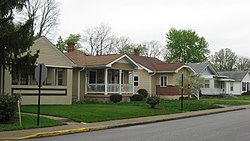Speedway Historic District | |
 Speedway Historic District, April 2011 | |
| Location | Roughly bounded by 16th St., Main St. 10th St. and Winton Ave., Indianapolis, Indiana |
|---|---|
| Coordinates | 39°47′02″N86°14′38″W / 39.78389°N 86.24389°W |
| Area | 41.6 acres (16.8 ha) |
| Architectural style | Late 19th and early 20th century American Movements, late 19th and 20th century Revivals |
| NRHP reference No. | 05001015 [1] |
| Added to NRHP | September 15, 2005 |
Speedway Historic District is a national historic district located in the town of Speedway, Indianapolis, Indiana, USA It encompasses 304 contributing buildings in a planned residential subdivision of Indianapolis. The district developed between about 1912 and 1955 and includes representative examples of American Foursquare and Bungalow / American Craftsman style architecture. [2]
It was listed on the National Register of Historic Places in 2005. [1]




